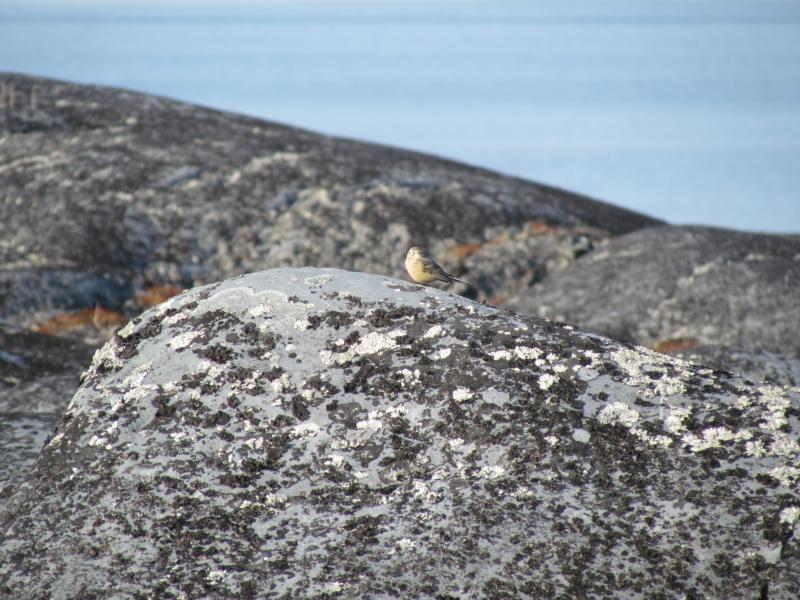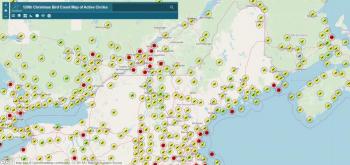How many activities can you participate in which you are coordinating with 79,000 other people to achieve a common goal? Not many, we would guess. But the National Audubon Christmas Bird Count is one of them. Last year more than 2,600 individual Christmas Bird Counts were conducted—1,974 from the United States, 460 from Canada, and 181 from the Caribbean, Latin America, and Pacific Islands.
Each Christmas Bird Count is established as a survey of all of the birds that occur within a fixed 15-mile diameter circle that does not overlap with any other count circle. The count must take place between mid-December and early January and, ideally, is carried out every year. Each count circle is divided up into territories, with separate teams covering their own section and counting all the birds of each species that they can find, all on the same day. All the section counts are then compiled together into a total number of individual birds of each species for the entire count circle.
The very first counts were started in 1900. Some Christmas Bird Counts have been taken annually without fail for many decades. Not surprisingly such a long-running and robust dataset has been invaluable in detecting changes in the abundance and distribution of birds. Hundreds of scientific papers and reports have been published from studies using the Christmas Bird Count dataset.
All of that is well and good, but the reality is that for most people, the motivating force to participate is about something else. It may be the feeling of being part of a team of committed and like-minded individuals. It may be a sense of adventure in visiting a new place or a difficult-to-access area. Maybe it is the thrill of competition to see who can find the most species or the most unusual bird or a new bird for the life list (the list of species a person has seen in their lifetime). Most often, it is a little of all of these things, perhaps with the anticipation of an end-of-day dinner with friends to share stories of the count.
We remember compilation dinners in warm, cozy living rooms after being out from before dawn on bitingly cold counts, waiting with anticipation to learn what interesting birds other teams had found and sharing with the delight our unusual finds—perhaps a lingering yellow-breasted chat at a backyard feeder or a very late American pipit among the wrack on a sandy beach. There was the lunchtime get-together that was traditional on the Orono-Old Town CBC where two birders came in trembling after helping pull an accident victim from a car just moments before it exploded. They continued counting birds that day and weeks later received awards from the local fire department for their bravery.
On the Schoodic Point Christmas Bird Count one year, the always adventurous duo of Norm Famous and Bruce Barker returned with a story about having to wade through frigid ocean water that had covered their return route from a small island connected by a natural causeway. They had been so engrossed with counting the birds on the island that they hadn’t paid attention to the rising tide. They sported slippers the rest of the day because their sodden boots were unwearable.
One night on our way back from the Misery Christmas Bird Count near The Forks, we met the other participants in a small-town restaurant. It had been an exceedingly cold day but we had been warmed by sightings of northern specialty birds like Canada jays, boreal chickadees, and black-backed woodpeckers. Still, our disappointment was keen when we learned that friends counting along the road to Harris Station Dam had found several exceedingly rare great gray owls just before dark. How we wished we could have found one in our territory!
Memories like this are what pull people into returning year after year to keep counting the birds on Christmas Bird Counts. And what an extra bonus to know that, together, all of us counting this year and those that counted in decades past are all part of a massive collective social event that tracks the health of the birds we love to observe. If you haven’t joined the Christmas Bird Count tribe and you want to, check out the National Audubon website to find a count you can be a part of at: https://www.audubon.org/conservation/join-christmas-bird-count
Jeffrey V. Wells, Ph.D., is a Fellow of the Cornell Lab of Ornithology. Dr. Wells is one of the nation's leading bird experts and conservation biologists and author of “Birder’s Conservation Handbook”. His grandfather, the late John Chase, was a columnist for the Boothbay Register for many years. Allison Childs Wells, formerly of the Cornell Lab of Ornithology, is a senior director at the Natural Resources Council of Maine, a nonprofit membership organization working statewide to protect the nature of Maine. Both are widely published natural history writers and are the authors of the book, “Maine’s Favorite Birds” and “Birds of Aruba, Bonaire, and Curaçao: A Site and Field Guide” from Cornell Press.































